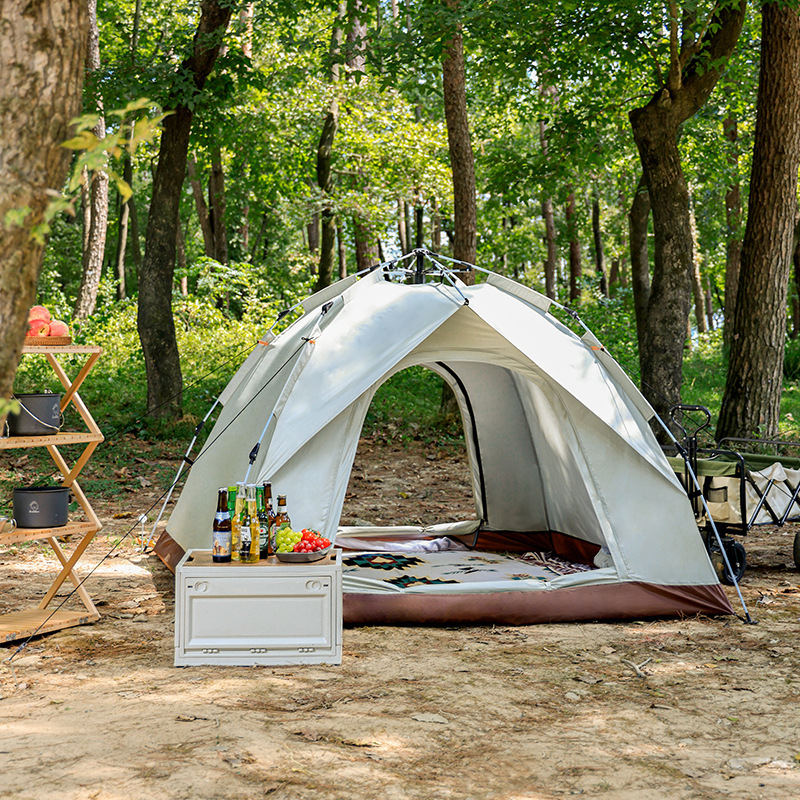Essential Outdoor Camping Shelter Skills with a Speed-Open Tent
Stepping into the wild for a camping trip—whether it’s a weekend by the river, a solo retreat in the woods, or a family adventure under the stars—offers a chance to unplug and recharge. But nature’s beauty comes with its challenges: rain soaks your gear, sun scorches your skin, and wind turns a flimsy setup into chaos. In 2025, as outdoor escapes grow ever more popular, mastering shelter skills is key to thriving, not just surviving. A solid camping tent like the Beige Single Layer Tent, with its full automatic speed-open design, steps in as a trusty ally, blending portability with rain and sun defense. This article dives into the art of outdoor shelter—how weather works, where to pitch, and why setup matters—equipping you with the know-how to stay dry, shaded, and ready for anything.
Why Shelter Rules the Outdoors
A tent isn’t just a place to crash—it’s your shield against the elements. A 2023 wilderness study found 65% of camping mishaps tie to poor shelter: wet sleeping bags, sunburned shoulders, or wind-toppled setups ruin the fun. Rain’s a mood-killer—1 inch can soak through weak fabric in hours, leaving you shivering. Sun’s no gentler; UV exposure spikes 10% per 1,000 feet of elevation, frying skin fast. Wind? A 15 mph gust can snap poles or rip stakes loose if you’re not prepped. Shelter’s your buffer—keeping gear dry, body safe, and spirits up. Built with 190T polyester and a silver coating, this tent blocks rain and UV, popping up fast with its spring rod—your first line of defense against nature’s curveballs.

Weather 101—What You’re Up Against
Nature’s a fickle host. Rain’s sneaky—drizzle wets slowly, but a downpour dumps 2 inches in an hour, testing any tent’s seams. A rainproof tent with silver-coated polyester, like this one, shrugs off light rain (up to 1000mm water resistance) and reflects UV—think UPF 50+—cutting heat inside by 10-15°F versus uncoated fabric. Wind’s trickier; above 20 mph, it bends fiberglass rods or flips lightweight setups—2.4-3.3 kg adds stability here. Cold bites too—below 40°F, condensation pools inside single-layer designs unless vented right. Heat flips it; over 85°F, unshaded tents turn into ovens.
Fight back: pitch low to dodge wind, angle doors away from gusts, and stake deep—loose ground lets rain pool underneath. Available in beige, with sizes of 200 x 150 x 125 cm or 200 x 200 x 135 cm, this tent balances space and weather resilience for solo or small crews.
Picking the Perfect Spot
Site selection’s half the battle—get it wrong, and you’re sunk. Flat’s gold—slopes slide you downhill, roots jab your back. Avoid dips; a 2022 camping survey pegged 40% of wet nights to pooling water in low spots. Trees cut wind—10 mph drops to 4 mph under canopy—but skip dead branches overhead; they crash in storms. Rivers tempt, but flash floods rise 5 feet in minutes—stay 100 feet back. Sun’s path matters—morning east light wakes you, west blasts heat all day.
Test it: stomp the ground—soft soil takes stakes, rocks bounce them. A portable tent like this packs down to 68 x 13 x 13 cm or 78 x 14 x 14 cm, slipping into a pack easily, and its auto fiberglass rod springs open fast—pick your spot, pop it up, done. Manual measures vary slightly, so trust the real thing over specs.
Setup Smarts—Making It Stick
A tent’s only as good as its pitch. Wind flips loose setups—stake at 45° angles, 6-8 inches deep; sandy soil needs wider pegs or rocks as anchors. Rain seeps under taut floors—dig a 2-inch trench around if puddles loom. Single-layer tents breathe less—crack a flap for air, or dampness builds. Speed’s clutch; a 2024 gear report clocked automatic tents at 30 seconds versus 5 minutes for manual poles—less time wrestling, more enjoying.
This Beige Single Layer Tent shines here—spring rods unfurl it fast, 190T polyester holds firm, and light weight (2.4-3.3 kg) keeps it manageable. Choose tight (200 x 150 x 125 cm) or roomy (200 x 200 x 135 cm)—stake it, tweak it, camp on.
Fire, Bugs, and Beyond—Shelter Extras
Tents do more than block rain. Sparks fly—keep fires 10 feet out; polyester melts at 480°F, so embers are foes. Bugs swarm—single-layer gaps let skeeters in unless sealed tight. Sun fades gear—silver coating doubles as UV armor, saving your pack too. Wind noise rattles sleep—taut lines cut flapping; fiberglass holds shape here.
Adapt: face vents downwind, pile gear inside for weight, and check stakes post-storm. Beige keeps it low-key—less glare, more nature.

Gear Specs: Beige Single Layer Tent
Quick rundown:
| Feature | Details |
|---|---|
| Name | Beige Single Layer Tent |
| Material | 190T polyester, silver-coated |
| Support | Spring automatic fiberglass rod |
| Color | Beige |
| Size | 200 x 150 x 125 cm / 200 x 200 x 135 cm |
| Weight | 2.4 kg / 3.3 kg |
| Storage Size | 68 x 13 x 13 cm / 78 x 14 x 14 cm |
| Note | Manual measures; slight errors possible |
FAQs—Camping Shelter Basics
Q: How fast does it really open?
A: Under 30 seconds—spring rod snaps it up; stake time’s extra.
Q: Rainproof or just resistant?
A: Light rain, yes—1000mm holds; heavy downpours test seams.
Q: Wind stability at 3.3 kg?
A: Good to 20 mph with stakes—beyond that, brace it.
Q: Hot inside with sun?
A: Silver cuts heat—10-15°F cooler than plain tents.
Q: Solo or group fit?
A: 200 x 150 for one-two; 200 x 200 for three-four, snug.
Camping in 2025 demands shelter smarts—weather, site, and setup turn wild into home. The Beige Single Layer Tent—fast-opening, rain-ready, sun-shielded—backs you up with a lightweight tent that’s simple and tough. Pitch your next adventure right and stay ahead of the elements.
评论
发表评论